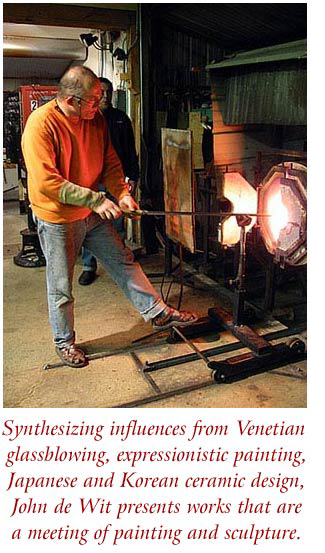John de Wit studied glass and ceramics at the
California State University in Chico in the late 1970s, attended the
Pilchuck Glass School and was a glassblowing assistant to Dale Chihuly.
He has since gone on to teach at Pilchuck, the Pratt Fine Art Center,
and several workshops and lectures in France. His current work
references the historic use of vessels and containers. De Wit states
that these eccentric, colorful vessels and scepters are “inspired by the
organic nature of Korean and Japanese ceramics and by the language of
Venetian glass.” He appreciates the versatility of glass and in it the
ability to combine expressive painting and sculpture.
John de Wit
traveled to Korea to accept his award at the 4th Annual
Cheongju International Craft Competition and Biennale. De
Wit's glass sculptures "Peer" and "Paard" were among
entrants to this exhibition. "Peer" was selected from
thousands of entries to receive the Silver prize in the
Craft Competition. His innovative vessels are discussed at
length in a feature article in the Fall 2005 issue of
Glass Quarterly.
For a second consecutive Biennale in Cheongju, Korea, John
de Wit is a recipient of one of the significant honors for
this prestigious symposium of international artists. The
Cheongju International Craft Biennale is an artistic
gathering of over three thousand participating artists from
more than fifty countries around the world.
Under this year’s main theme
“Creative Evolution: Deeply and Slowly,” the mission of the
Biennale is to bring a world focus to the value of
handcrafted art as its place in our technology driven world
diminishes. Creative Evolution refers to the unending
progress and adaptation of ideas as societies develop with
the immutable change in our natural environment.
John was presented with a Gold Prize for his submission
of a painted and blown glass sculptural vessel titled ‘Beck’, with the
award came a $10,000 monetary award and trophy.